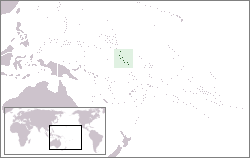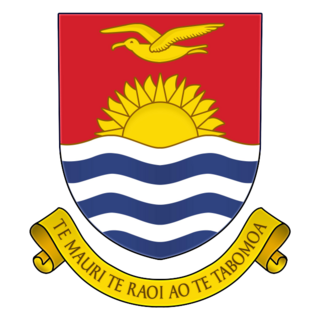
The International Red Cross and Red Crescent Movement is an international humanitarian movement with approximately 17 million volunteers, members and staff worldwide which was founded to protect human life and health, to ensure respect for all human beings, and to prevent and alleviate human suffering.

The islands which now form the Republic of Kiribati have been inhabited for at least seven hundred years, and possibly much longer. The initial Micronesian population, which remains the overwhelming majority today, was visited by Polynesian and Melanesian invaders before the first European sailors visited the islands in the 17th century. For much of the subsequent period, the main island chain, the Gilbert Islands, was ruled as part of the British Empire. The country gained its independence in 1979 and has since been known as Kiribati.

Politics of Kiribati takes place in a framework of a parliamentary representative democratic republic, whereby the President of Kiribati is the head of government, and of a multi-party system. Executive power is exercised by the government. Legislative power is vested in both the government and the House of Assembly. The Judiciary is independent of the executive and the legislature. The constitution promulgated at independence on 12 July 1979, establishes the Republic of Kiribati as a sovereign democratic republic and guarantees the fundamental rights of its citizens.

Kiribati is a full member of The Commonwealth, the IMF and the World Bank, and became a full member of the United Nations in 1999. Kiribati hosted the Thirty-First Pacific Islands Forum in October 2000. Kiribati has Least Developed Country Status and its interests rarely extend beyond the region. Through accession to the Cotonou Agreement, Kiribati is also a member of the African Caribbean and Pacific Group. Kiribati maintains good relations with most countries and has particularly close ties to Pacific neighbours Japan, Australia, and New Zealand. Kiribati established diplomatic relations with Taiwan in November 2003. Kiribati briefly suspended its relations with France in 1995 over that country's decision to renew nuclear testing in the South Pacific.

The flag of Kiribati is red in the upper half with a gold frigatebird flying over a gold rising sun (otintaai), and the lower half is blue with three horizontal wavy white stripes to represent the ocean and the three groups. The 17 rays of the sun represent the 16 Gilbert Islands and Banaba.

The Gilbert Islands are a chain of sixteen atolls and coral islands in the Pacific Ocean about halfway between Papua New Guinea and Hawaii. They form the main part of Kiribati.
Taetae ni Kiribati or Gilbertese, also Kiribati, is a Micronesian language of the Austronesian language family. It has a basic verb–object–subject word order.

Tarawa is an atoll and the capital of the Republic of Kiribati, in the central Pacific Ocean. It comprises North Tarawa, which has much in common with other, more remote islands of the Gilberts group; and South Tarawa, which is home to 56,284 people as of 2010 – half of the country's total population. The atoll is best known by outsiders as the site of the Battle of Tarawa during World War II.

The 180th meridian or antimeridian is the meridian 180° both east and west of the Prime Meridian, with which it forms a great circle dividing the earth into the Western and Eastern Hemispheres. It is common to both east longitude and west longitude. It mostly passes through the open waters of the Pacific Ocean, but passes across land in Russia, Fiji and Antarctica. This meridian is used as the basis for the International Date Line, but the latter deviates from it to maintain date consistency within the territories of Russia, the United States, Kiribati, Fiji and New Zealand.

The coat of arms of Kiribati officially known as the National Emblem of Kiribati is the heraldic symbol representing the Central Pacific island nation of Kiribati. The arms feature a yellow frigatebird over a rising sun on a red background among white and blue stripes and the 3 groups of stripes represent. The 17 rays of the sun represent the 16 Gilbert Islands and Banaba. On the ribbon under the shield is the Gilbertese motto Te Mauri Te Raoi Ao Te Tabomoa.

The International Federation of Red Cross and Red Crescent Societies is a worldwide humanitarian aid organization that reaches 160 million people each year through its 190-member National Societies. It acts before, during and after disasters and health emergencies to meet the needs and improve the lives of vulnerable people. It does so with impartiality as to nationality, race, gender, religious beliefs, class and political opinions.
According to 2010 government statistics, Christian groups form about 96% of the Kiribati population by census counts, most of whom are either Catholic or members of the Kiribati Uniting Church. Persons with no religious affiliation account for about 0.05% of the population. Members of the Catholic Church are concentrated in the northern islands, while Protestants are the majority in the southern islands.
Japanese presence in Kiribati dates back to the 20th century when labourers were hired to work in Kiribati's phosphate mines. As compared to the other Micronesian countries which came under Japanese rule in the first half of the 20th century, the majority of the Japanese consisted of transient workers and only a few settled in Kiribati. Since Kiribati became independent in 1978, a few Japanese have also taken permanent residence in Kiribati, and assumed important positions within Gilbertese society.

This is a survey of the postage stamps and postal history of Kiribati.

The Junior Red Cross Society (JRC) is a voluntary humanitarian organization to protect human life and health based in India. It is part of the International Red Cross and Red Crescent Movement, and so shares the Fundamental Principles of the International Red Cross and Red Crescent Movement. The society's mission is providing relief in times of disasters/emergencies and promoting health & care of vulnerable people and communities. It has a network of over 700 branches throughout India. The Society uses the Red Cross as an emblem in common with other international Red Cross societies. Volunteering has been at the very heart of the Indian Red Cross Society since its inception in 1920, with the Society having Youth and Junior volunteering programmes. The Society is closely associated with the St John Ambulance in India.

Women in Kiribati are women who live in or are from the atoll nation of Kiribati. The role of Kiribati women is described in the publication Kiribati, A Situation Analysis of Children, Women and Youth (2005) as "largely defined by her age and marital status". Prestige is inherent to the married Kiribati woman, but she is considerably under the authority of her husband.
The honours system of Kiribati was established by the Kiribati National Honours and Awards Act 1989. This act created a system of awards to recognize exemplary, meritorious or distinguished service, "in, for, or to Kiribati". The awards are divided into two categories, civil and disciplined forces. Awards are conferred by the Beretitenti, upon the advice of the Cabinet. The awards are as follows in their order of precedence:












